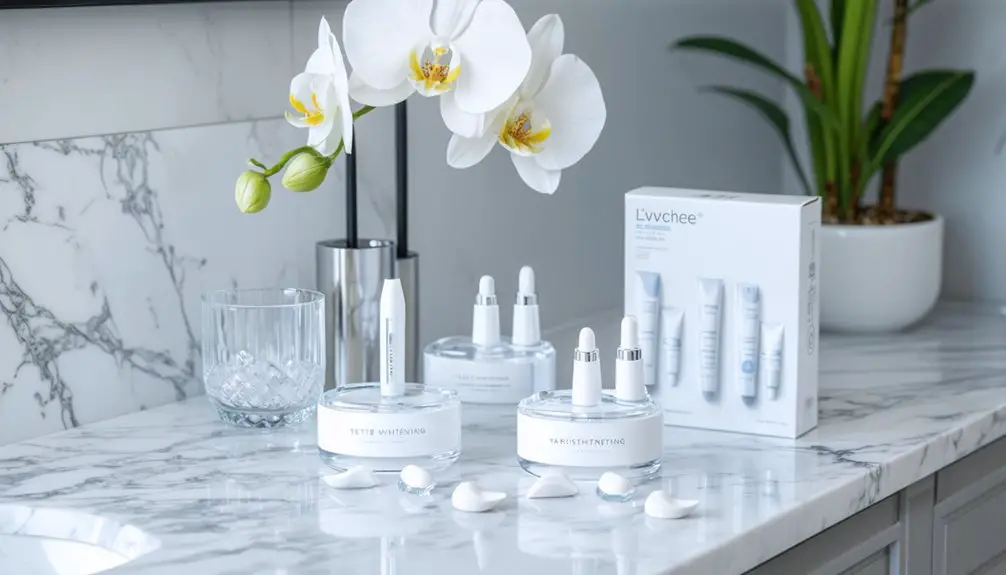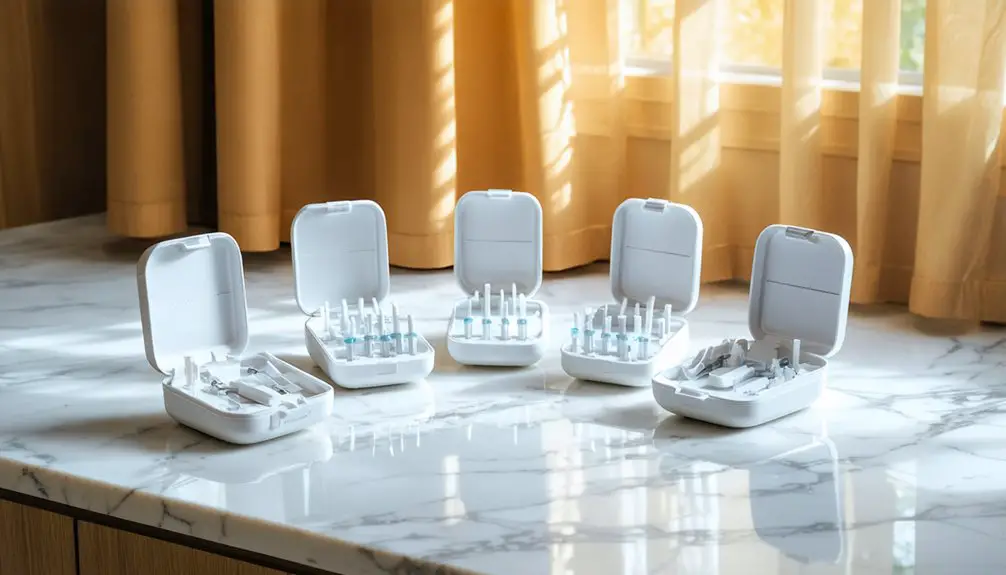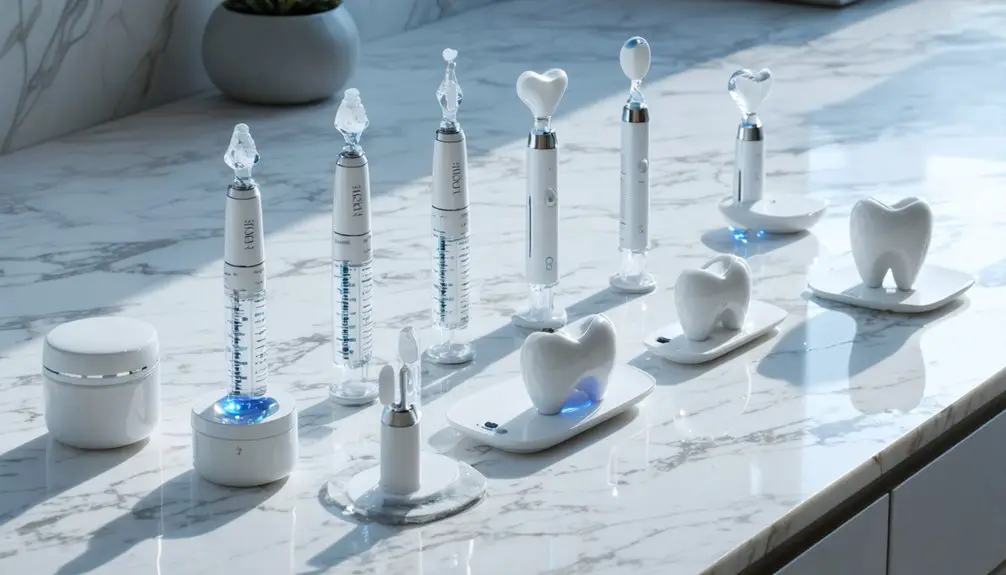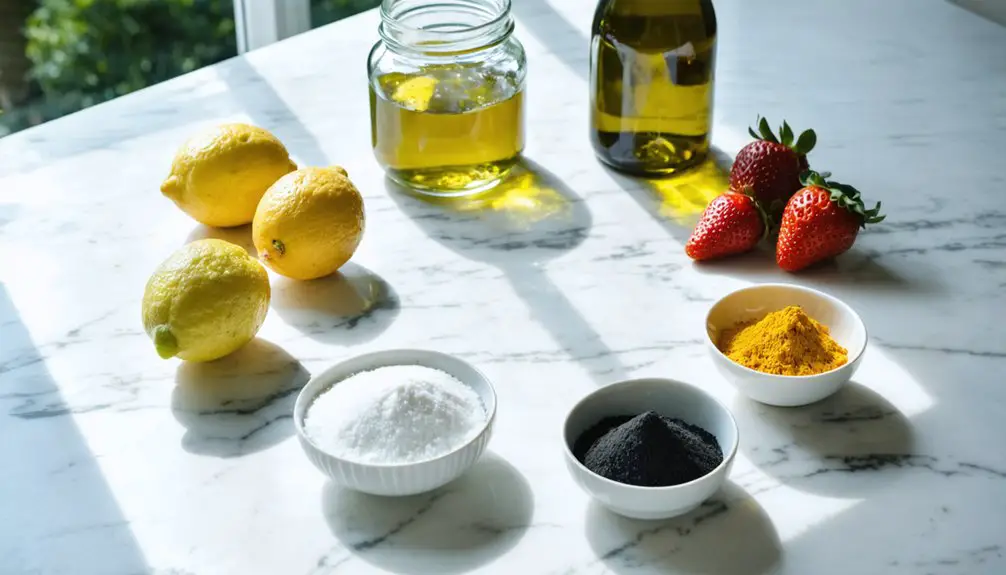You’ll find effective teeth whitening results at home using budget-friendly kits that range from $10-60. Popular options include whitening strips, LED kits, and tray systems containing proven ingredients like hydrogen peroxide or carbamide peroxide. These products can lighten teeth 2-8 shades within 1-2 weeks of consistent use, making them a cost-effective alternative to $1,200 professional treatments. Understanding the right application methods and safety guidelines will help maximize your whitening success.
Key Takeaways
- Whitening strips cost between $10-$45 and show results within 1-2 weeks of daily use.
- LED whitening kits improve teeth by 2-5 shades in 7-10 days using light-accelerated gel treatments.
- Over-the-counter products range from $5-$60, offering significant savings compared to professional treatments costing up to $1,200.
- Tray-based systems provide prolonged contact with whitening agents for deeper whitening at home.
- Budget-friendly options contain FDA-approved concentrations of hydrogen peroxide (up to 6%) or carbamide peroxide (up to 15%).
Understanding Active Ingredients in Home Whitening Products
While teeth whitening has become increasingly popular for at-home use, understanding the active ingredients in these products is essential for both safety and effectiveness.
The primary active ingredients you’ll find in home whitening kits are hydrogen peroxide and carbamide peroxide, with the latter breaking down into hydrogen peroxide for a slower, more sustained release. These chemical mechanisms work through oxidation, breaking down stain molecules to lighten your teeth. Calculating the active oxygen content means dividing the carbamide peroxide concentration by 2.7668.
Over-the-counter products typically contain 3-10% hydrogen peroxide or 10-15% carbamide peroxide, concentrations that balance results with safety. Proper storage procedures, such as refrigeration, can help maintain the effectiveness of these peroxide-based products.
When you’re choosing a whitening kit, remember that higher concentrations work faster but may increase sensitivity. For the safest experience, look for products within FDA-approved limits of 6% hydrogen peroxide or 15% carbamide peroxide.
Popular Types of Budget Teeth Whitening Systems
Now that you understand how whitening agents work, let’s explore the most cost-effective teeth whitening options available for home use.
Whitening strips offer an affordable entry point at $10-$45 per kit, providing noticeable results within 1-2 weeks of daily 5-30 minute applications. The Up&Up strips deliver impressive whitening with 2.9 shades lighter in a 20-day treatment period.
For enhanced effectiveness, LED-based whitening kits combine gel treatments with light acceleration, typically showing 2-5 shade improvements in 7-10 days. The LED light acts as a catalyst that speeds up results 30-50% compared to gel treatments alone.
If you’re seeking deeper whitening effects, tray-based systems deliver prolonged contact with whitening agents through moldable or boil-and-bite formats.
Those with sensitive teeth can opt for peroxide-free alternatives using natural ingredients, though results develop more gradually.
For maintenance between treatments, whitening pens and specialized toothpastes offer convenient touch-ups, making them practical supplements to your primary whitening routine.
Safety Guidelines and Best Practices
Before starting any teeth whitening regimen, consulting with your dentist is essential to guarantee the treatment’s safety and suitability for your specific dental condition.
A safety consultation will help identify potential issues like gum disease, cavities, or dental restorations that could affect your results.
Always follow product instructions precisely, as overuse can lead to sensitivity and enamel damage.
Most home whitening treatments should last 10-14 days, and you’ll need to rinse thoroughly after each application.
Using non-bleach products provides a gentler option for those with sensitive teeth.
If you experience severe sensitivity, reduce exposure time or take breaks between treatments.
Stop using the product immediately and contact your dentist if you develop persistent pain or irritation.
Meader Family Dentistry professionals can provide personalized guidance on selecting the most suitable whitening products for your needs.
Choose ADA-approved products with regulated concentrations of hydrogen peroxide or carbamide peroxide, and avoid unproven DIY remedies that could harm your teeth.
What Results to Expect From At-Home Treatments
Although at-home teeth whitening kits won’t match the dramatic results of professional treatments, you can expect to achieve noticeable improvements of 2-8 shades lighter with consistent use.
You’ll likely see initial changes within 1-2 weeks when using products with 10-16% carbamide peroxide, with maximum results appearing after 2-4 weeks of regular application. Recent advancements have made these treatments highly effective, with success rates reaching 90%.
Your whitening expectations should account for several factors that influence success, including your initial tooth color and the type of stains you’re treating. With two-thirds of Americans having tried some form of teeth whitening, these at-home methods have proven to be a popular choice for achieving a brighter smile.
The results can last from a few months up to 3 years, though treatment duration varies based on your habits. You’ll need periodic maintenance treatments to preserve your results, especially if you consume staining foods and beverages.
For ideal outcomes, complement your whitening routine with fluoride products to protect your enamel.
Cost Analysis and Value Comparison
When comparing teeth whitening options, you’ll find significant price variations between over-the-counter (OTC) and professional solutions.
While professional take-home kits range from $150 to $600, OTC products cost between $5 and $60, making them more accessible for budget-conscious consumers.
Professional treatments can cost up to $1,200 for in-office procedures.
To maximize cost effectiveness, consider that strips and trays generally deliver better results than pens or toothpaste alone.
Mid-range products like Crest Whitestrips can achieve 2.6 shades of whitening in 19 days, though results develop more gradually than professional treatments.
Insurance plans typically do not include teeth whitening coverage, as it is considered a cosmetic procedure.
When evaluating product longevity, remember that OTC options typically require more frequent maintenance treatments.
While their initial cost is lower, you may need multiple applications over time.
Professional treatments, despite higher upfront costs, often provide longer-lasting results with fewer touch-ups needed.
Application Tips and User Experience
Successful teeth whitening at home depends heavily on proper application techniques and attention to detail. To avoid common application mistakes, start by thoroughly brushing and flossing your teeth, then guarantee they’re completely dry before treatment.
Place small drops of gel in each tooth impression rather than spreading it throughout the tray.
For effective sensitivity management, begin with shorter wearing times of 30-60 minutes and gradually increase duration if you don’t experience discomfort.
You’ll want to clean your trays after each use with cold water and store them properly to maintain their shape. Keep the gel in a cool, dry place, and avoid consuming staining beverages for 24 hours post-treatment.
Most users see visible results within six sessions when following these guidelines carefully.
Frequently Asked Questions
Can I Whiten My Teeth if I Have Dental Crowns or Veneers?
You can whiten your natural teeth, but crowns compatibility means restorations won’t change color. For veneers maintenance, consider professional cleaning instead, as whitening products don’t affect their shade.
How Long Should I Wait to Whiten Teeth After Professional Dental Cleaning?
Like giving your smile a well-deserved rest, you’ll need to wait 1-2 weeks after your dental cleaning before whitening. This timeline guarantees your enamel’s protective layer regenerates, preventing sensitivity.
Is It Safe to Whiten Teeth While Pregnant or Breastfeeding?
You shouldn’t whiten your teeth while pregnant due to safety concerns for your baby. If you’re breastfeeding, consult your dentist first. Focus on alternative methods like proper brushing and flossing instead.
Can Teenagers Use At-Home Teeth Whitening Kits?
You shouldn’t use at-home whitening kits until you’re at least 14-16 years old. For teenage safety and whitening effectiveness, consult your dentist first, as young teeth are more sensitive to whitening agents.
Will Whitening Treatments Affect Existing Dental Fillings?
Your whitening treatments won’t change the color of your filling materials, as they’re non-reactive to bleaching agents. Whitening effectiveness only applies to natural teeth, potentially creating shade differences between fillings and teeth.
References
- https://g-p-dental.com/best-teeth-whitening-kits-in-2025-safe-option/
- https://nhdentistrybeverlyhills.com/press/6-of-the-best-teeth-whitening-kits-in-the-drugstore/
- https://www.goodhousekeeping.com/health-products/g28723133/best-at-home-teeth-whitening-products/
- https://smiletouch.fr/en/blogs/news/comparaison-des-produits-de-blanchiment-dentaire-lequel-choisir
- https://www.youtube.com/watch?v=_jhezrXFqSA
- https://drgeorges.com/dental-white/teeth-whitening-system-comparisons/
- https://pmc.ncbi.nlm.nih.gov/articles/PMC10024105/
- https://gloscience.com/blogs/blog/before-it-goes-in-your-mouth-check-your-ingredients
- https://www.advancedsmilesmarion.com/resources/best-online-teeth-whitening-kits
- https://deandentalsolutions.com/the-best-at-home-teeth-whitening-worth-trying/



